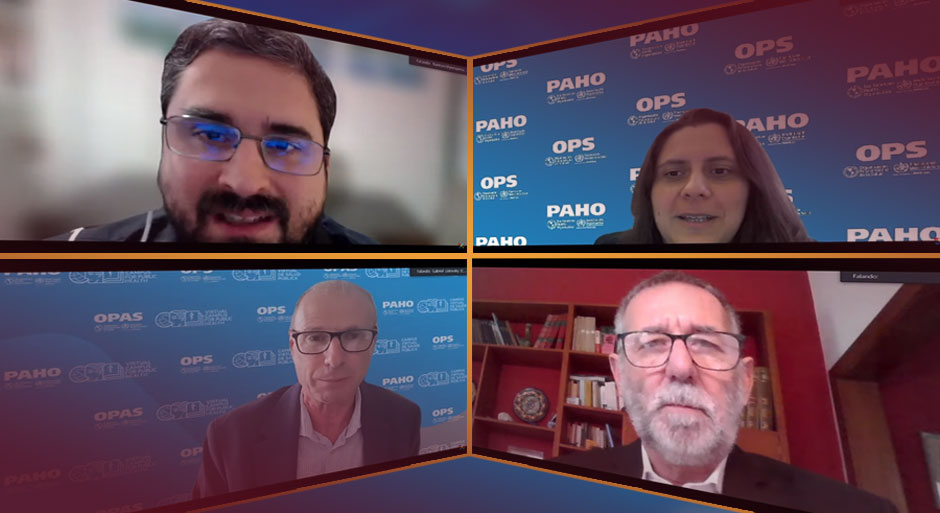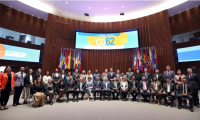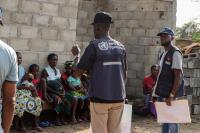Polytechnic School promotes webinar “Profile and educational trajectories of health technicians at the Virtual Public Health Campus”

In the year in which it completes 20 years as a World Health Organization (WHO) Collaborating Center for the Education of Health Technicians, the Joaquim Venâncio Polytechnic School of Health (EPSJV/Fiocruz) promoted, on April 16, the webinar “Profile and educational trajectories of health technicians who take courses at CVSP/Opas”. Held in partnership with the Pan American Health Organization (PAHO), the event aims to present the platform and methodology used in a research that analyzes the trajectory and experience of health technician users who have already taken courses at the Virtual Campus of PAHO Public Health through a characterization of the sociodemographic and work profile of these workers and a survey of the courses most frequently offered by health technicians at the regional level.
Opening table
“In addition to 20 years as a collaborating center, we also completed 20 years of reactivating RETS [International Network for the Education of Health Technicians]. Bringing light to this huge contingent of technical workers is essential for us to think about strengthening the national health systems of the countries that make up the American continent and in all the countries in which we have cooperation”, stated Anamaria Corbo, director of EPSJV, at the opening table.
The director also spoke about the importance of the project giving visibility to technical health workers. “We know that technical workers make up the largest percentage of the health workforce and, since the creation of RETS, we have talked about the importance of bringing visibility to who these workers are, where they are, what they do, what qualifications and how they work. institutions can strengthen and qualify these workers. It is within this scope that the project falls”, she highlighted.
In the same sense, Gisele Almeida, from the Health Human Resources Unit at PAHO/WHO, highlighted that the learning and maturing journey is an important step to give visibility to this group of health workers. “Despite their number and importance, they end up diluted in the Americas region, due to the great differences we have related to the responsibilities and training of these workers”, she commented. And he added: “In this trajectory of human resources work in health, we find a situation in the Americas region in which inequalities in the working conditions and salaries of health professionals and a lack of psychosocial support persist, with repercussions on mental health and well-being. be. There is also a low attraction and retention of workers in rural, remote and underserved areas; Information systems on the health workforce are non-existent, incomplete or fragmented, not allowing the use of this data. In view of this, joint actions are essential to achieve our common objectives.”
Public Health Virtual Campus
When starting his presentation, Gabriel Listovsky, director of CVSP/Opas, emphasized: “It is essential to know these workers, know where they work, what their concerns and training needs are. In this sense, this meeting is essential for decision-making.”
CVSP's mission, according to Gabriel, is to contribute to the development of the capabilities and skills of health workers, supporting the transformation of public health services and practices in the Americas region. “Our challenge is that each health worker can work in the best way and with our communities in mind. Our principles, which are aligned with PAHO’s values, have to do with the perspective of public good, Permanent Health Education, open and interoperable resources, collaborative management and sustainability,” he stated.
Currently, courses are offered at CVSP in all PAHO/WHO technical areas. “We have around 100 self-study courses, open in the organization’s four official languages. In 2023, we had a total of three million users and six million course enrollments. In other words, this means that those who arrive for one course later enroll in others. Furthermore, we have users from more than 225 countries”, he pointed out.
To conclude, Gabriel presented some data about health technicians enrolled at CVSP. “Of the total number of users, around 15% identify themselves as technicians. Excluding nursing, the first three groups of professionals who identify as technicians are laboratory technicians, community health agents and care workers. Furthermore, countries with large rural areas, such as Bolivia, have reported difficulties in accessing the educational offer on the virtual campus,” he concluded.
Panorama of parameterization and standardization of WHO technical health occupations
“Effective planning, management and policymaking for developing a health workforce suited to the needs of the population and health services requires reliable data and information. In this sense, the WHO launched, in 2017, the National Health Workforce Accounts (CNPS)”, stated Ana Paula Cavalcante, from the Health Human Resources Unit at PAHO/WHO. According to her, the CNPS is a tool that allows countries to progressively improve the availability, quality and use of HRH data by monitoring a set of indicators and other health objectives.
Also according to Ana Paula, data collection takes place as follows: “Health workforce data is monitored and reported on the national accounts platform by focal points appointed by each member state annually, following norms and standardizations. presented; This data is evaluated through a process that involves data analysis, triangulation of information, among other methods, in which discrepancies are verified with these focal points. The WHO also receives data from external sources and partners, such as the OECD [Organization for Economic Co-operation and Development]. The data is published annually, both on the national accounts portal and on the Global Health Observatory”.
Profile and educational trajectories of health technicians
Data analyst who makes up the project team, Fernando Santoro presented the preliminary results of the research on the profile of technicians who use the Virtual Campus. The presentation discussed the detailed process of cleaning and analyzing data from the records of professionals who chose the "other" option when declaring their professions during registration on the platform.
Fernando explained that a time frame was carried out, filtering only enrollments in self-learning courses, from January 2018 to December 2023, dividing into pre-pandemic, pandemic and post-pandemic. Then, the data was filtered to isolate the records of professionals who did not fit into the pre-defined categories, reducing the base to 1,218,025 registrations. Finally, the data was filtered, eliminating categories that do not belong to the technical level, reducing the base to 531,243 registrations.
According to the data analyst, after refinement, it was possible to recover 153,622 valid registrations, representing 29% of the total after the first cleaning filter. “The methodology adopted allowed for a more in-depth and precise analysis of the types of professionals who use the virtual campus for self-learning, rescuing 153,622 non-standard enrollments. This preliminary study is essential to better understand how different professional groups engage with the distance education resources offered by CVSP, contributing to future improvements and adaptations of the system to users' needs”, highlighted Fernando.
After selecting the self-administered courses and classifying all technicians enrolled in the virtual campus into 23 categories of the International Classification of Occupations, the national coordinator of the National Nursing Training Program (Pronafe), from Argentina, Gabriel Muntaabski, who also makes up the project team , highlighted that the first approaches to the analysis show a growth in people and enrollments at the CVSP of more than 400% for the period mentioned, presenting 340,088 registered people with an average of 2.2 registrations per registered person. “The highest prevalence is presented by nursing technicians, followed by community health agents, laboratory technicians and health administrators”, he stated.
This work, according to him, presents challenges of different orders. "Continuity of the project with the identification by country of the prevalence of professions and courses chosen by health technicians; the behavior of different countries in the pre-pandemic, pandemic and post-pandemic periods and the vacant areas of supply or demand. Adaptations are necessary to achieve the broadest training coverage of this important group of health workforce in the Americas”, he concluded.



